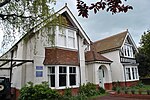Eastbourne ( (listen)) is a town and seaside resort in East Sussex, on the south coast of England, 19 miles (31 km) east of Brighton and 54 miles (87 km) south of London. Eastbourne is immediately east of Beachy Head, the highest chalk sea cliff in Great Britain and part of the larger Eastbourne Downland Estate.
The seafront consists largely of Victorian hotels, a pier, theatre, contemporary art gallery and a Napoleonic era fort and military museum.
Though Eastbourne is a relatively new town, there is evidence of human occupation in the area from the Stone Age. The town grew as a fashionable tourist resort largely thanks to prominent landowner, William Cavendish, later to become the Duke of Devonshire. Cavendish appointed architect Henry Currey to design a street plan for the town, but not before sending him to Europe to draw inspiration. The resulting mix of architecture is typically Victorian and remains a key feature of Eastbourne.As a seaside resort, Eastbourne derives a large and increasing income from tourism, with revenue from traditional seaside attractions augmented by conferences, public events and cultural sightseeing. The other main industries in Eastbourne include trade and retail, healthcare, education, construction, manufacturing, professional scientific and the technical sector.Eastbourne's population is growing; between 2001 and 2011, it increased from 89,800 to 99,412. The 2011 census shows that the average age of residents has decreased as the town has attracted students, families and those commuting to London and Brighton. In the 2021 census, the population of Eastbourne was 101,700.







